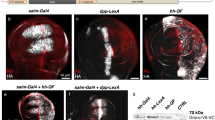Abstract
When a wild-type strain ofNeurospora crassa is transformed with different portions of the carotenogenic albino 1 or albino 3 genes, up to 30–35% of the transformants show an albino phenotype. The albino transformants presented a variety of phenotypes ranging from white or yellow to dark yellow colour. The ectopically integrated sequences provoke a severe impairment of the expression of the endogenousal-1 oral-3 genes. This phenomenon, that has been termed quelling, is found to be spontaneously and progressively reversible. In fact, all of the albino transformants have an unstable phenotype and revert progressively to wild type or intermediate phenotypes over a prolonged culturing time. The phenotypic reversion is characterised by a progressive release of the transcriptional inhibition and seems to correlate with the reduction of the number of the ectopic integrated sequences. However, there is no strict correlation between the copy number of the ectopic sequences and the intensity of quelling, as indicated by the existence of albino transformants containing only 1–2 ectopic sequences. The nature of the molecular events determining the onset of quelling is unclear, in any event, these are likely to involve some kind of interaction between the resident genes and ectopically integrated exogenous sequences. Recent evidences on a possible mechanism are presented.
Similar content being viewed by others
References
Barry C, Faugeron G & Rossignol J (1993) Methylation induced premeiotically inAscobolus: Coextension with DNA repeat lengths and effect on transcript elongation. Proc. Natl. Acad. Sci. USA 90: 4557–4561
Bird AP (1986) CpG rich islands and the function of DNA methylation. Nature 321: 209–213
Brussian JA, Karlin-Neumann GA, Lu Huang & Tobin EM (1993) An Arabidopsis mutant with a reduced level of cab140 RNA is a result of cosuppression. Plant Cell 5: 667–677
Bull JH & Wootton JC (1984) Heavily methylated amplified DNA in transformants ofNeurospora crassa. Nature 310: 701–704
Carattoli A, Romano N, Ballario P, Morelli G & Macino G (1991) TheNeurospora crassa carotenoid biosynthetic gene (albino-3) reveals highly conserved regions among prenyltransferases. J. Biol. Chem. 266: 5854–5859
Cedar H (1988) DNA methylation and gene activity. Cell 53: 3–4
de Carvalho F, Gheyesen G, Kushnir S, van Montagu M, Inze D & Castresana C (1992) Suppression of β-1–3 glucanase transgene expression in homozygous plants. EMBO J. 11: 2595–2602
Doerfler W (1983) DNA methylation and gene activity. Ann. Rev. Biochem. 52: 93–124
Ebbole D & Sachs MS (1990) A rapid and simple method for isolation ofNeurospora crassa homokaryons using microconidia. Neurospora Newslett. 37: 17–18
Elkind Y, Edwards R, Mavandad M, Hedrick SA, Ribak O, Dixon RA & Lamb CJ (1990) Abnormal plant development and down regulation of phenylpropanoid biosynthesis in trnsgenic tobacco containing a heterologous phenylalanine ammonia lyase gene. Proc. Natl. Acad. Sci. USA 87: 9057–9061
Faugeron G, Rhounim L & Rossignol JL (1990) How does the cell count the number of ectopic copies of a gene in the premeiotic inactivation process acting inAscobolus immersus? Genetics 124: 585–591
Goring D, Thomson L, & Rothstein SJ (1991) Transformation of a partial nopaline synthase gene into tobacco suppresses the expression of a resident wild-type gene. Proc. Natl. Acad. Sci. USA 88: 1770–1774
Goyon C & Faugeron G (1989) Targeted transformation ofAscobolus immersus andde novo methylation of the resulted duplicated sequences. Mol. Cell. Biol. 9: 2818–2827
Hart CM, Fischer B, Neuhaus JM & Meins F (1992) Regulated inactivation of homologous gene expression in transgenic Nicotiana sylvestris plants containing a defense-releted tobacco chitinase gene. Mol Gen. Genet. 235: 179–188
Jones PA (1985) Altering gene expression with 5-azacytidine. Cell 40: 485–486
Matzke MA, Primig M, Trnovsky J & Matzke AJM (1989) Reversible methylation and inactivation of marker genes in sequentially transformed tobacco plants EMBO J. 8: 643–648
Mittelsten Scheid O, Paszkowski J & Potrykus I (1991) Reversible inactivation of a transgene inArabidopsis thaliana. Mol. Gen. Genet. 228: 104–112
Mol J, van Blockland RV & Kooter J (1991) More about cosuppression. Trends Biotech. 9: 182–183
Napoli C, Lemieux C & Jorgensen R (1990) Introduction of a chimeric chalcone synthase gene into Petunia results in reversible co-suppression of homologous genes in trans. Plant Cell 2: 279–289
Nelson M & McClelland M (1989) Effect of site specific methylation or DNA modification methyltransferases and restriction endonucleases. Nucleic Acid Res. 17, supplement: r389–415
Nelson MA, Morelli G, Carattoli A, Romano N & Macino G (1989) Molecular cloning of aNeurospora crassa carotenoid biosynthtic gene (albino-3) regulated by blue light and the products of white collar genes. Mol. Cell. Biol. 9: 1271–1276
Pandit NN & Russo VEA (1992) Reversible inactivation of a foreign gene, hph, during the asexual cycle inNeurospora crassa transformants. Mol. Gen. Genet. 234: 412–422
Razin A & Riggs AD (1980) DNA methylation and gene function. Science 210: 604–610
Romano N & Macino G (1992) Quelling: Transient inactivation of gene expression inNeurospora crassa by transformation with homologous sequences. Mol. Microbiol. 6: 3343–3353
Schmidhauser TJ, Lauter FR, Russo VEA & Yanofsky C (1990) Cloning, sequence and photoregulation of al-1, a carotenoid biosynthetic gene ofNeurospora crassa. Mol. Cell. Biol. 10: 5064–5070
Selker EV (1990) Premeiotic instability of repeated sequences inNeurospora crassa, Ann. Rev. Genet. 24: 579–613
Selker EV, Cambareri EB, Jensen BC & Haach KK (1987) Rearrangement of duplicated DNA in specialized cells of Neurospora. Cell 51: 741–752
Smith CJS, Watson CF, Bird CR, Ray J, Schuch W & Grierson D (1990) Expression of a truncated tomato polygalacturonase gene inhibits expression of the endogenous gene in transgenic plants. Mol. Gen. Genet. 224: 477–481
van der Krol AR, Mur LA, Beld M, Mol JNM & Stuitje AR (1990) Flavonoid genes in petunia: Addition of a limited number of gene copies may lead to a suppression of gene expression. Plant Cell 2: 291–299
Author information
Authors and Affiliations
Rights and permissions
About this article
Cite this article
Cogoni, C., Romano, N. & Macino, G. Suppression of gene expression by homologous transgenes. Antonie van Leeuwenhoek 65, 205–209 (1994). https://doi.org/10.1007/BF00871948
Issue Date:
DOI: https://doi.org/10.1007/BF00871948




